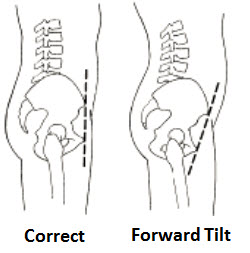Walking right – stride and posture
We take walking for granted. After all, we’ve all been doing it since were were only a year old. But if you want to stay healthy and mobile, it’s important to pay attention to the proper stride and posture in walking.
The proper stride and posture enables you to walk farther, use less energy and reduce the risk of injury. On the other hand, the muscles in the back often get shortened, compressed and very tight if you’re not walking properly.
Dr. Vance Bonner, author of The Vance Stance, is a specialist in body mechanics, kinesiology, and exercise therapy. According to Bonner, proper posture and gait while walking starts with proper posture when you’re standing.
 The pelvis should be level, from back to front. “Think of it as a pail of water,” Bonner said. “As you walk or stand, that pail of water shouldn’t spill. It’s held level, even as you’re moving forward.”
The pelvis should be level, from back to front. “Think of it as a pail of water,” Bonner said. “As you walk or stand, that pail of water shouldn’t spill. It’s held level, even as you’re moving forward.”
The most common fault is to have the pelvis pitching forward as you walk… as if the water’s spilling out the front.” That can cause all sorts of problems, especially in your back.
Beware of shoes that make you feel like you’re leaning forward as you walk.
The pelvis should also be level from side to side. If it’s not level when you’re just standing, you may need an orthodic in one shoe.
Bonner says the ankle is the most important joint in your body, and the most underused. “The ankle joint lays the foundation for everything above it… hips, lower back, even the shoulders can be effected by how well your ankles work.”
When you walk, you should consciously use your toes, feet and ankles, not just your hips.
Frozen ankles and feet are often the cause of a strange, and older-than-your-age gait. You’re basically walking like an old man. So if you’ve had a history of sprains or broken ankles, you might want to do some specialized exercises or PT.
Try Bending your knees more deeply… you’ll feel it in your ankles.You must bend at the knees and ankles deeply enough to engage the bigger leg muscles… the quadraceps. Don’t lock your knees, either when standing or walking.
A proper gait, along with the right walking shoes, will minimize the effects of the contact phase.

Shoulders back and down.
Is your neck in a forward position, with the chin jutting out? Or is it stacked neatly above the spine?
If your gait is irregular, it’s going to be inefficient, and will cost more in energy. The worse or more inefficient the gait, the greater will be the energy expenditure.
If you want to get technical about it, here’s a breakdown of the gait: According to Physiopedia:

Heel Strike
Heel strike, also known as initial contact, is a short period which begins the moment the foot touches the ground and is the first phase of double support.[3] 30° flexion of the hip and full extension in the knee is observed. The ankle moves from a neutral (supinated 5°) position into plantar flexion.[3][4] After this, knee flexion (5°) begins and increases, just as the plantar flexion of the heel increased.[4] The plantar flexion is allowed by eccentric contraction of the tibialis anterior, extension of the knee is caused by a contraction of the quadriceps, flexion is caused by a contraction of the hamstrings, and the flexion of the hip is caused by the contraction of the rectus femoris.[4]
Foot Flat
In foot flat, or loading response phase, the body absorbs the impact of the foot by rolling in pronation.[3] The hip moves slowly into extension, caused by a contraction of the adductor magnus and gluteus maximus muscles. The knee flexes to 15° to 20° of flexion. [4]Ankle plantar flexion increases to 10-15°.[3][4]
Midstance
In midstance the hip moves from 10° of flexion to extension by contraction of the gluteus medius muscle.[4] The knee reaches maximal flexion and then begins to extend. The ankle becomes supinated[3] and dorsiflexed (5°), which is caused by some contraction of the triceps surae muscles.[3] During this phase, the body is supported by one single leg. At this moment the body begins to move from force absorption at impact to force propulsion forward.[3]
Heel Off
Heel off begins when the heel leaves the floor. In this phase, the body weight is divided over the metatarsal heads.[3] Here can we see 10-13° of hip hyperextension, which then goes into flexion. The knee becomes flexed (0-5°)[4] and the ankle supinates and plantar flexes.[4]
Toe Off
In the toe-off/pre-swing phase, the hip becomes less extended. The knee is flexed 35-40° and plantar flexion of the ankle increases to 20°.[3][4] In toe-off, like the name says, the toes leave the ground.[4]
Early Swing
In the early swing phase the hip extends to 10° and then flexes due to contraction of the iliopsoas muscle[4] 20° with lateral rotation.[3][4]The knee flexes to 40-60°, and the ankle goes from 20° of plantar flexion to dorsiflexion, to end in a neutral position.[3]
Mid Swing
In the midswing phase the hip flexes to 30° (by contraction of the adductors) and the ankle becomes dorsiflexed due to a contraction of the tibialis anterior muscle.[4] The knee flexes 60° but then extends approximately 30° due to contraction of the sartorius muscle.[3][4] This extension is caused by the quadriceps muscles.[3][4]
Late Swing
The late swing/declaration phase begins with hip flexion of 25-30°, a locked extension of the knee and a neutral position of the ankle.[3]
